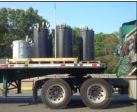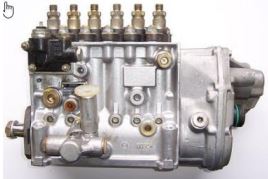Making Sure You are Ready for an EMP

[November 2017] This is Part 4 of Glen Clark’s look at the dangers EMPs (Electromagnetic Pulses) present to broadcasters, and how to minimize damage from them.
If you have just started reading this series about EMPs, and missed the first three parts, here is the basic point to accept: if an EMP happens, most likely you will be on your own.
From this point forward, let us discuss what planning is necessary to keep your station up and running after an EMP.
(While not an EMP, the Hurricane Maria was almost as deadly in that all but three stations on Puerto Rico were said to be off the air for days/weeks after the hurricane. The commonality – no commercial power. The stations were on their own. )
Do Not Rely on the Power Grid
To summarize the four parts that deliver AC to the wall outlet beside your desk are:
- the generating station
- transmission line
- step-down transformers
- supervisory and control circuits
The generating station itself is way upstream from your station, and beyond the scope of this article. Just accept that it may fail in an EMP.
Transmission lines fail by over-Voltage and carbon tracking. The steel support towers will withstand an EMP as will the conductors. The vulnerability in the transmission lines is in the insulators. (In utility company jargon, the insulators are also called “bushings.”)
The chances that any one transmission line insulator will fail may be small. But there are hundreds of insulators between each step-down station and the next. And all it takes to short one leg of the circuit to ground is one shorted bushing.
Transmission line bushings are cheaper to warehouse in an underground vault than are transformers. But, as the total number of bushings needed could be in the hundreds or even thousands, the capital tied up in the vault would not be small.
Suits at the utilities are likely to not be in favor of anything more than a skeletal stocking of spares, until the power goes off on the street where they live.
Stepping Down
 By and large, the issue of step-down transformers was covered in Part 1.
By and large, the issue of step-down transformers was covered in Part 1.
“Pole Pig” transformers like these will be in short supply in the event of a successful EMP attack.
Manufacturers and local utilities do keep a thin inventory of common sizes and models, enough inventory to rebuild the grid after a large storm. But the present reserves of these long lead time items are insufficient to rebuild the grid after an EMP.
Certainly, a broadcaster cannot fix a step-down transformer for a utility. And a broadcaster cannot replace a dozen insulator bushings for a utility. So why is a discussion of these components even mentioned in this article? To drive home this one point:
In the event of a large-scale EMP, you may be on your own for months. In the event of a hurricane, utility crews from 200 miles away will be dispatched with conga-lines of cherry-picker trucks and wood chipper trucks that stretch along the interstates for miles. In the event of an EMP, those distant work crews and trucks will have problems to deal with at home. And they won’t be racing to your rescue. Your local utility will be on its own. How fast can they acquire replacement transformers? How fast can they acquire replacement insulator bushings? How fast can your local utility get these new components installed?
What Do You Think Will Happen?
The public perception of what would happen in the event of an EMP really has become a caricature of itself.
Every TV news service has what is called “B-roll footage” of people evacuating in front of an approaching hurricane via an interstate highway. The two southbound lanes are empty – and the two northbound lanes are at a standstill.
That B-roll footage is close enough to what would happen after an EMP that few could tell the difference. The newscast would probably follow that B-roll footage with more B-roll, showing gas stations with signs over the pumps saying “NO GAS.”
This is the public perception of a loss of infrastructure due to an EMP: cars that will not move and gas pumps with no gas. What is there to know that is not in the clichéd B-roll?
But it gets worse up above.
Post EMP in Tall Buildings
In the absence of commercial power, tall buildings essentially become worthless.
Everyone seems to understand the obvious: the elevators would stop and people would have to take to the stairs. However, the building’s HVAC is more than air conditioning. The “V” is ventilation, which is recycling stale air with fresh air.
Even if the outdoor temperature is at a comfortable level, the air needs to be recycled. Most high-rise buildings have enough diesel generating capability to keep the red “EXIT” signs lit in the stairwells. But few buildings have enough diesel generating capacity to maintain normal habitability and environment in the tenant spaces.
Buildings taller than just a few floors also have boost pumps for the water supply. Firefighting water is a different discussion. The point here is that the water fountain on the 28th floor and the ladies room on the 81st floor will not have water. How long is that likely to be habitable?
Just consider: if every tall building in downtown Kansas City is unusable in the event of an extended outage of the AC commercial power or if every tall building in downtown Minneapolis and in downtown Denver and in downtown Miami is unusable – what then?
Getting the Right View
Essentially, you should just take a mallet and smash the intuitive belief that, a few days after the crisis, help, with plentiful replacement components, will arrive from afar and the commercial power will be back on soon.
If you do so, be warned that it will cause you to make wrong choices.
In the event of an effective EMP attack, being prepared to operate in stand-alone mode for two weeks will not be enough. People are just beginning to ask “what can be done?” But, in reality, no one has the answer.
Planning: What to Protect
.. and for how long.
We have talked in previous installments about how and when an adversary might use an EMP. And we have talked about the modes of equipment failure if some residual of the EMP does reach sensitive circuits.
But there is a gap in understanding the middle. If a pulse does arrive at the surface of the earth, how does it get into the equipment to cause damage?
For broadcasters, the three most likely routes of ingress to studio and transmitter rooms:
- AC power mains
- control and communications lines (including phone lines)
- antennas
Which is the most likely of the three? The answer is mind-numbingly simple. If it looks like an antenna, it is a dangerous pulse collector. The larger the antenna (pulse collector) is, the higher the Voltage will likely be which gets inside the equipment
Many sources suggest that an EMP is a giant flux wave that kills every electrical or electronic device in its path. The actual (non-movie) reality is a bit different. The flux wave is much less likely to interact with individual bond wires, individual silicon chips, or with individual power line insulator bushings.
One of the most frequently-asked questions is if the reader’s smartphone will continue to work after an EMP. The surprisingly answer is that most smartphones will probably survive if there are no earbuds attached. Earbuds, actually, the wires to them, are a signal collector (antenna).
AC Power Mains
The largest source, by far, of havoc in most equipment rooms will be the commercial AC power service.
Unless the last 100 feet to the building are buried underground, the power lines are a wonderful antenna – and a dead power line can zap you.
Even if a Voltmeter shows zero Volts across the incoming mains, it is still an efficient ingress route for the second pulse. If a utility breaker has opened five miles from your utility demand meter or if a step-down transformer has failed five miles from your demand meter, that five-mile transmission line between that fault and you is still a great antenna. It does not even have to be connected to anything on the far end to be a large danger.
Therefore, if an incoming power feed is not providing power, be sure to disconnect it. If there is no other way, open the big breaker closest to the snorkel. But it would be far preferable to open a knife switch or to remove the 3-phase bank of cartridge fuses.
Power Off Danger
Surprisingly to some, your equipment does not need to be turned on for the EMP to kill it.
If your smartphone is turned off but the earbuds deliver a pulse inside the handset, the handset will fail in the same way as if it had been turned on when the pulse arrived. Likewise, if your digital exciter has the on/off power switch in off position, that provides zero protection. None.
Why not? If the pulse has started 50 miles above the surface of the earth, coupled into a power line, made it through the breaker box and arrived at the power on/off switch, it is not going to let a 1/4-inch gap inside the switch stop it.
Thus, power switches that are integral to a piece of equipment in a rack provide zero protection against a pulse. If you really want to protect something, you should have it isolated inside a metal enclosure, completely disconnected from the world.
Indeed, the number of ways that a system can be wiped out by a “backfeed” are too many to mention. If a pulse ever comes, there will be many systems the owners believed were protected which will be wiped out because the pulse arrived in a way that was not anticipated.
Control and Comm Lines
Fiber is good in your diet. And data fiber is good – maybe the best – for moving data in and out of equipment areas.
Here is why: CAT5 cable has copper-to-copper connectivity, which will bring the pulse into the equipment room. POTS line telephone circuits have copper-to-copper connectivity, which also will bring the pulse into the equipment room.
Thus, anywhere that you need to move data, use fiber if at all possible.
The Danger From Antennas
A Scala antenna for a 960 MHz STL or a “Roto-tiller” FM antenna – even though they both have the word “antenna” in their name – may be poor signal collectors.
Both of these devices are designed to work above 80 MHz. On the other hand, most, if not all, of the power in an EMP is below 10 MHz. So the Scala and the Rototiller may not be particularly efficient at converting the EMP into Voltage at the down end of the coax.
Yet, the coax itself may serve as an efficient vertical whip antenna across the part of the spectrum band containing the EMP. Coax lines can bring a significant portion of the pulse into the equipment room. But the method might be different from what you would intuitively expect.
The Diesel Generator
A skydiver takes more than a casual interest in his parachute. A scuba diver takes more than a casual interest in his breathing apparatus. And in the event of an extended power outage, the diesel generator becomes just as vital.
Some people, especially those along the Gulf coast and along both coasts of Florida, seem to grasp the idea of an extended power outage. Recently, I have received stories of broadcast engineers in Toledo and Indianapolis who are making extreme preparations for a possible EMP. This a prudent course to take.
What is the diesel manufacturer’s recommended time between oil changes for your generator when running at 50% load? What is the manufacturer’s recommended time when running at 100% load?
Your diesel is your lifeline. Know it. Hug it. Love it.
Generator Maintenance
For the Long Term
It is a wise move to buy enough oil and oil filters to last for six months.
The accounting department will scream because this expenditure is not in the budget and will “screw up this quarter’s numbers.” Yet, there is more at stake here than this quarter’s numbers. After an EMP, oil and oil filters will be rare like plywood and bottled water when there is a hurricane a day away.
Just as there is no guarantee that there will only be one EMP, there is also no guarantee that the EMP(s) will arrive during warm weather. A dipstick oil heater is an essential item for some stations in northern latitudes.
Back in the days of manned transmitter sites, most transmitter sites were heated. Making the indoors warm enough for the operators to be comfortable also insured that the oil was always warm enough to allow the diesel to start.
Sites built without heat in northern states may find the generator difficult to start on cold days.
Similarly, be prepared for someone to live at the transmitter site depending on your particular situation. That certainly flies in the face of recent custom, but we have not had an EMP recently, either.
Do not forget to keep awareness of security issues paramount in your thinking. For example, gasoline and diesel are universal fuels. Any Joe on the street who needs to fire up their pickup can use them.
That means the fuel outside is a lightning rod for miscreants who feel no need to play by the rules. The old rules will not apply. After an EMP is uncharted territory. Think underground or otherwise secure fuel storage.
For many folks, security video cameras which scan all access roads, all doors to the building, the generator, and the fuel tank are essential.
Propane and Natural Gas: Problem Solvers?
In contrast, the only common use for propane and natural gas is home heating and buses.
City laws often prohibit gasoline and diesel from tall building installations. On the other hand, propane and natural gas are likely permitted on tall buildings.
If you are acquiring a new generator, compare the ease of fuel theft for each. Does propane make fuel theft less likely at your plant?
The three standard metrics for every petrofuel are:
- BTU-per-pound
- BTU-per-cubic foot and
- BTU-per-dollar
where the BTU (British Thermal Unit) is a measure of energy.
While diesel fuel and gasoline do have remarkably high energy densities – a small volume of gasoline contains a large amount of energy – at the same time, the energy density of propane is lower.
In addition, propane cannot be siphoned away in the middle of the night like gasoline or diesel fuel can be. Removing propane from your tower site requires large specialized equipment which is not very stealthy.
Generator Auto-Start Issues
Please be cautious with auto-start mechanisms.
Whether they are modern computer-driven units or old-style relay units, giving the auto-start full authority may not be the best idea. It may be wise to inhibit some or all of the functions.
Keep in mind that the algorithms incorporated into auto-start units are designed to get the generator up and running quickly when certain conditions are met. That is not a bad rule set if the genset is covering for a phone pole taken out by careless driver.
Yet it might be exactly the wrong course of action for an EMP event.
Will Your Generator
Run After an EMP?
Yes. No. Maybe.
If the generator goes to be with Jesus, it will probably be the blinky-blinky flashy-flashy-type that dies, not the simple diesel engine or the large alternator. The less MPMS (“Microscopic Puddles of Molten Silicon”) electronics included in a genset, the more likely it is to survive an EMP.
The most useful grouping for generator types in this conversation is:
- gasoline/natural gas with points-plugs-condenser ignition
- gasoline/natural gas with electronic ignition
- diesel with mechanical injector pump
- diesel with high-pressure rail and electronic timing.
Prior to the 1970s, almost all diesel engines used a mechanical injector pump (see photo).

For a typical six-cylinder engine, there were six thin steel tubes from the injector pump to the individual cylinders. Gears and levers inside the pump insured that each cylinder would get its squirt of high-pressure fuel at precisely the right time. The timing algorithm was built into the gears and levers.
In the 1980s, engineers developed an alternative configuration.

Instead of multiple tubes, the new design had a single high-pressure pump which fed a single high-pressure “rail.” The new design had one high-speed electronically-timed valve at each cylinder.
The “single rail” system was infinitely more flexible. Changes in pulse timing and duration were accomplished in software. One did not have to install a new set of gears to change the timing.
The two big advantages of the new system were that extremely configurable timing allowed for better fuel efficiency and for reduced air pollution. But the single-rail system has a lot of fragile electronics to drive it. The MPMS blinkey-blinkey-flashy-flashy is the weak spot in the system
Choosing the Right Generator
If fuel consumption or pollution products are the highest priority, then the blinkey-blinkey-flashy-flashy is the best choice.
But, if a better chance of surviving an EMP is your only concern, then you want a diesel that is as dumb as a rock, as basic as a Soviet dump truck. You want the old style diesel with the mechanical injector pump.
Many of the mechanical injector diesels have no electronics on them other than the battery and the starter motor. The cable between those items is short and does not make much of an antenna.
In fact, once the engine is running on a mechanical injector pump unit, even the battery is superfluous.
As with many other things, intuitive is incorrect here. Newer technology which requires four pounds of circuit boards to drive the high-speed valves is not the better solution. An older, low-tech diesel is more likely to survive an EMP.
What About Gasoline Engines?
A recently manufactured gasoline engine with lots of electronics has the same weak spot as described above for a diesel engine.
Actually, an older points-plugs-condenser gas engine would have higher reliability. The plug wires are short, so they are not particularly efficient as an antenna. While, parts for older auto engines are in short supply, replacement parts for older farm tractors are often easy to find.
The Ford Model “N” is one of those tractors where parts seem to be easiest to find. The Model N was made in the 1940s and 1950s.
If you are interested enough in EMPs to still be reading this fourth part, spending some time with a search engine looking for “PTO (Power Take Off) generator” and “Three-Point-Hitch Generator” could make you smile.
For example, you can buy a hefty alternator which comes with no engine. It has the mounting hardware to attach to the rear of a PTO-equipped farm tractor. Exactly how, if at all, a PTO generator would be useful in your plant depends on local factors. But the PTO generator is a very flexible device which might be worth consideration.
Next time, we will finish up with a discussion of long term operations, a useful checklist and a discussion of how various pieces of hardware will perform.
– – –
Part 1 – The EMP Will Be Worst Than You Think
Part 2 – Three Ways EMPs Kill Electrical/Electronic Devices
Part 3 – EMP Dangers in the Broadcast Plant
Part 5 – Long Term System Survival From EMP
– – –
Glen Clark was the founder of TEXAR and the designer of the AUDIO PRISM.

